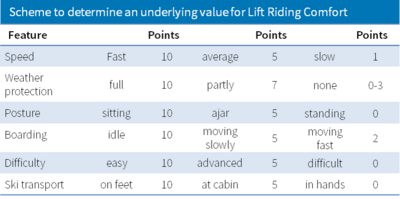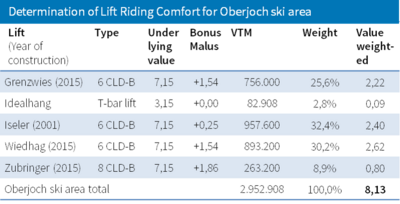Lift riding comfort

The following theses on lift riding comfort served as the basis for the development of a valuation method:
- the faster a lift, the better the comfort
- the more complete the weather protection, the more comfortable it is to use
- sitting during the ride is more comfortable than standing
- it is more comfortable to get into a standing vehicle than to get into a slow or even fast vehicle
- difficulties in use (correct timing, coordination of movements, balancing uneven surfaces, etc.) reduce comfort
- the way of ski transport influences the comfort of the ride, it is most unfavourable if the skis or boards have to be held in the hand, holding devices are better, it is best to be able to keep the skis at the feet
- on the other hand a high degree of freedom while the vehicle is in motion is positive
- level-walk-in, conveyor belt access and lifting tables increase ease of entry
- a longer distance between the vehicles relaxes the boarding situation and thus increases comfort
- heated seats additionally increase comfort
- spacious gondolas in which you are able to stand upright are more comfortable than less spacious gondolas
- padded seats are more comfortable than unpadded ones
- Wi-Fi additionally increases the comfort of a ride.
For the operationalization, six main characteristics were initially selected and their potential values were located on a ten-point scale. After that, 30 common types of lifts were assigned a corresponding scale value for each of these main characteristics. For the speed feature for example, the fastest lifts (aerial tramways with 12 m/s) have a maximum value of 10, magic carpets a value of 1.
To derive an underlying value for each type of lift, a weighting of the features is required, which was determined as follows:
- Speed 10%
- Weather protection 20%
- Posture 20%
- Boarding 20%
- Difficulty 15%
- Ski transport 15%.
A survey on the significance of these features is currently being conducted and can be taken here.
On the basis of this weighting, these results are used as underlying values for some of the 30 types of lifts taken into account:
- Pulsed gondola with seats 8.8 points
- Gondola with seats 8.2 points
- Detachable chairlift with covers 7.2 points
- Fixed grip chairlift 4.9 points
- Button lift 3.6 points
- T-bar lift 3.2 points.
By using such underlying values, a number of factors do not need to be determined in detail for each lift, as they are already included in the coverage of the lift type.
The respective ratings for all types of lifts are shown here.
Some cost-driving factors will be considered as bonus factors in this methodology:
- Access conveyor belt +0.400 points
- Heated seats +0.400 points
- Chair distance >5 sec, per extra second +0.125 points
- Level-walk-in for gondolas +0.600 points
- Wi-Fi +0.300 points
- Lifting table +0.200 points
- Child protection +0.200 points.
A survey on the significance of these features is currently being conducted and can be taken here.
The cabin size of gondola lifts and the seating comfort of chair lifts are taken into account as a negative factor in relation to the age of the lifts, since exact information on cabin and chair types is less available than the years of construction:
- Built before 1980 -1.500 points
- Built 1980-1989 -1.000 points
- Built 1990-1999 -0.500 points
- Built 2000-2009 -0.250 points
- Built since 2010 no deduction.
Once a comfort value has been determined on this basis for each individual lift in a ski area, the overall valuation follows. For this purpose, the different lifts have to be weighted. This weighting is based on the vertical transport capacity (VTM = transport capacity in persons per hour x altitude difference of the lift), as the particularly powerful lifts of a ski area also carry a particularly large number of guests who can enjoy the comfort of these high-performance lifts.
The following table illustrates the determination of the lift comfort value using the Oberjoch ski area as an example.

Montenius has created a database which includes all lifts in the Alps as well as in major non-Alpine ski areas and allows to analyse them properly.
The following table shows examples of some ski areas. It can be seen that the large French ski areas do not reach very high values. Chairlifts with weather protection are rare in these areas, and there are only a few with heated seats. In fact, Espace Diamant is the world's largest ski area without any gondola. The Matterhorn Ski Paradise takes its toll on the high proportion of aerial tramways and glacier lifts in terms of lift comfort. The most recently renovated Ifen is at the top of the list, while Kronplatz occupies first place among the larger ski areas. Ylläs, the largest ski area in Finland, has a high proportion of T-bar lifts, which is quite common in Scandinavia, and the luxurious Deer Valley ski area does not even have a chairlift with weather protection.
| Ski area | Country | Lift riding comfort |
|---|---|---|
| Les Trois Vallées | France | 6.50 |
| Espace Diamant | France | 4.96 |
| Laax | Switzerland | 6.82 |
| Matterhorn Ski Paradise | Switzerland/Italy | 6.95 |
| Saalbach-Hinterglemm | Austria | 7.71 |
| Kronplatz | Italy | 8.46 |
| Ifen | Austria | 8.76 |
| Snowmass | USA | 5.74 |
| Deer Valley | USA | 5.51 |
| Vail | USA | 6.05 |
| Sun Peaks | Canada | 5.47 |
| Whistler Blackcomb | Canada | 6.38 |
| Ylläs | Finland | 4.07 |

